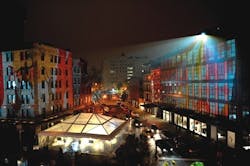Experience as Material: Transforming Architecture into Communications Media
New developments and innovations create unique opportunities for each generation of architects. One of the most significant developments of our time, digital display technology, has literally changed the face of architecture. Media has become a vital material.
The emergence of "experience" as a material began in the theater. Set designers (many trained as architects) such as Mark Fisher in Great Britain and Jerome Serlin in the United States began using integrated, panoramic projection to create image-driven spaces in the 1970s. A seminal event in the public conscience was Pink Floyd's 1980 production of The Wall Live, which merged engineered architectural forms with dramatic, filmic storytelling to create something new and remarkable. These evocative theatrical environments created their own inertia, and soon every major rock tour, theme park, and Broadway show seemed to have "spectacular" visual effects.
Today, the image surface has become part of our daily context at every level (take a look down at your phone). In the architectural world, the primary driver behind image surface has been marketing and sales. Urban media structures, by their sheer scale and proximity, provide a powerful means to communicate and sell. In many cases the designs have been little more than 3-D billboards, but as the public grows more discriminating this has begun to change.
One of my company's recent projects, Victory Park Screens (see ARCHI-TECH, July/August '08), is a sophisticated design developed by an interdisciplinary team focused on a series of objectives. The media is a combination of digital fine artwork by artists from around the world and high-image advertising by limited sponsors. The delivery mechanism is a series of HD-quality LED screens, many moving on rails to add visual dynamism. The context is created by two new buildings that define an urban space and support the LED and motion systems as well as lighting and audio effects. Says architect Richard Orne of TFO Architecture, "The inherent challenge in designing a kinetic environment like [Victory] is to synchronize the separate systems of message, architectural form, and meaning in a seamless fashion." The result is more than the sum of the parts: a new crossroads for Dallas, an art statement to the world, and a magnet for upscale retail and residential development.
In today's cities, any building or group of buildings can potentially be an expression of anything at any time. In May, digital imagery transformed an entire neighborhood of New York. The artwork of 45 prominent artists—from Philippe Starck to A Bathing Ape—took over the meatpacking district for the launch of iGoogle. An undertaking months in the planning? "Less than a month from first client contact to go live," says Patrick Connolly, CEO of event and media designers Obscura Digital.
The tools we have today in show production and immersive communications are simply phenomenal. There is no longer even a clear distinction between R&D and implementation. We write code and modify gear on-site to respond to opportunities. The digital display tools that architects are using today (such as LED display, digital playback, and pixel mapping) all evolved from technologies initially developed for theatrical and entertainment design.
To relate what might be coming next, I'd like to focus on two powerful trends we see in our industry.
- Social Networking. In the worlds of MySpace, Second Life, and Twitter, things are just different. People expect to generate and control their environments and their interactions. Surpassing Google's painting of a neighborhood with digital artwork, broad populations may soon be able to dictate their own physical worlds. Get ready for tenants, their friends, and all their friends to decorate the building you create today. From September 21 to 25 of this year, one of my clients—Oracle Corp.—is transforming the entire neighborhood around San Francisco's Moscone Convention Center into a giant digital communication architecture for up to 40,000 users as part of its Oracle OpenWorld Conference.
- Rapidly Evolving Interfaces. Says Chris Lejeune of Obscura Digital, "Imagery is becoming more organic and accessible. Right now, media is independent from architecture, but we're beginning to see the integration of media and architecture. There was Blade Runner, and soon our cities reflected that vision. There was Minority Report, and soon the iPhone was born. Can the Iron Man house be far way?" Not long after I interviewed Chris, our companies combined with Elements Design Group of San Francisco to bring that type of interface to life in a project for the world's leading nanomanufacturing company, Applied Materials.
Will digital display grow to dominate the world of architectural surface? Of course not. A recent visit to the Vietnam Veterans Memorial reminded me of the remarkable power of traditional architectural materials. But Jenny Holzer's digital installation at 7 World Trade Center may offer clues to what's ahead. Holzer's memorial in LEDs, like Maya Lin's in stone, is comprised solely of words. Both are beautiful, moving, and elegantly executed. Both projects represent the future: a future that will not be a contest between digital media and traditional materials, nor a struggle between corporate marketing and individual expression, nor a battle between new ideas and traditional thinking. This inclusive future will be much more about "and" than "or." Get ready for a fun ride.
San Francisco-based Foghorn Creative provides creative direction and coordination for immersive communications projects worldwide. Specializing in developing highly dimensional digital media, the company serves a who's who of clients from the entertainment and technology industries. Don Richards ([email protected]), Foghorn creative director, has led dozens of immersive communication projects worldwide, including work for clients such as Oracle, Cisco Systems, E*TRADE, MGM Studios, Cirque du Soleil, Victory Park Screens, and Lucasfilm Ltd. He holds a bachelor of arts degree from Rice University as well as a master of arts degree in design and a master of architecture from the University of California at Berkeley, where he has also taught. Richards was the recipient of the Dorothea Lange fellowship in photography and is a licensed architect.
back to top
IMAGES:
